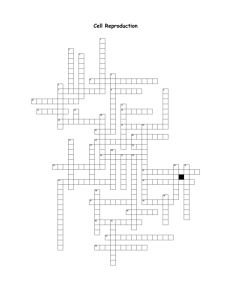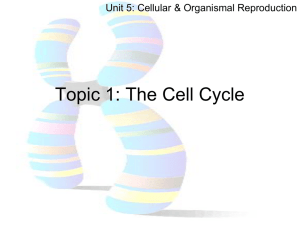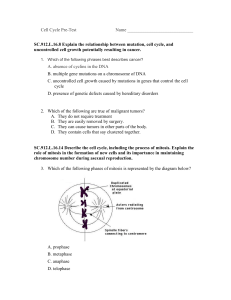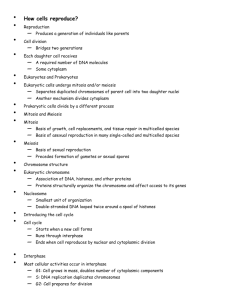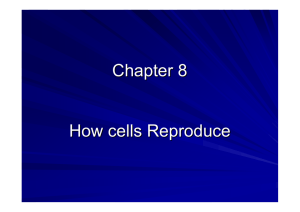Mitosis and Asexual Reproduction Notes
advertisement
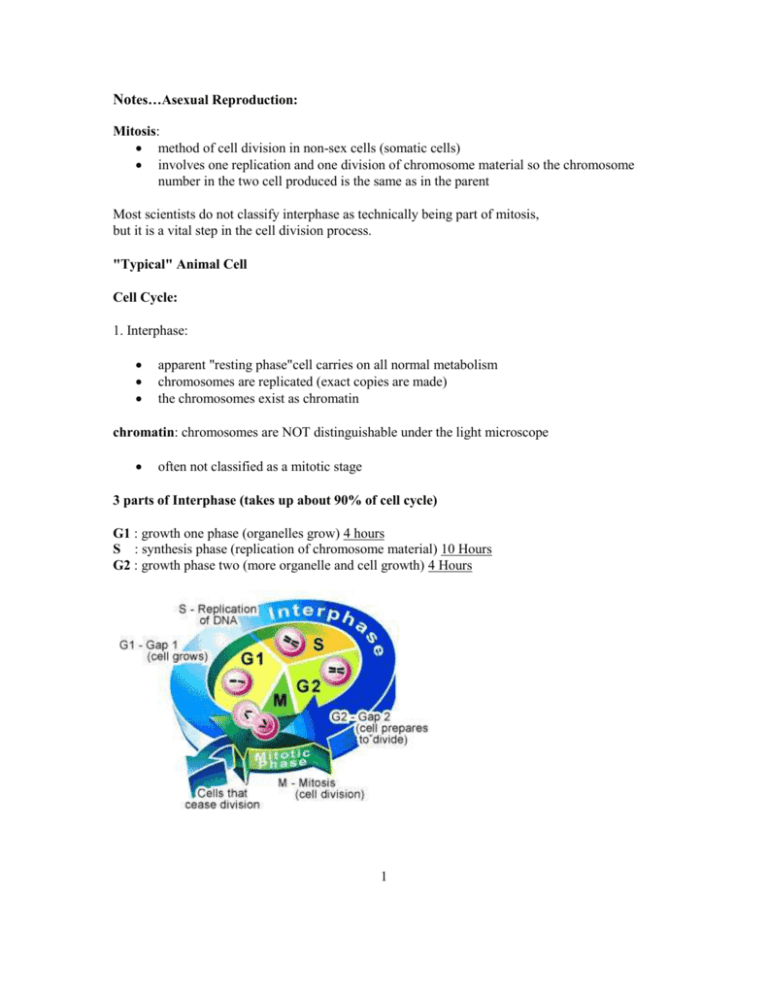
Notes…Asexual Reproduction: Mitosis: method of cell division in non-sex cells (somatic cells) involves one replication and one division of chromosome material so the chromosome number in the two cell produced is the same as in the parent Most scientists do not classify interphase as technically being part of mitosis, but it is a vital step in the cell division process. "Typical" Animal Cell Cell Cycle: 1. Interphase: apparent "resting phase"cell carries on all normal metabolism chromosomes are replicated (exact copies are made) the chromosomes exist as chromatin chromatin: chromosomes are NOT distinguishable under the light microscope often not classified as a mitotic stage 3 parts of Interphase (takes up about 90% of cell cycle) G1 : growth one phase (organelles grow) 4 hours S : synthesis phase (replication of chromosome material) 10 Hours G2 : growth phase two (more organelle and cell growth) 4 Hours 1 2. Mitosis: 2nd part of Cell Cycle…AKA: Cell Division 2 hours A. Prophase: centrioles begin to separate are connected by spindle fibers made of protein chromosomes can now be distinguished (appear as short rods) nucleus breaks apart with nucleolus and nuclear membrane disappearing chromosomes appear coiled and doubled in appearance chromatid: each chromosome strand centromere: (kinetochore): holds the chromatids together B. Metaphase: centrioles move to opposite poles of the cell connected by the spindle each doubled chromosome moves to the center of a cell along a spindle fiber C. Anaphase: centromeres replicate and each doubled chromosome separates to form two chromosomes in late Anaphase cytoplasmic division begins and the cell membrane begins to pinch in D. Telophase: spindle apparatus disappears nuclear membrane reforms around 2 new nuclei containing 1/2 the metaphase cell's chromosomes centrioles replicate in late telophase -- cell division occurs in late telophase Graphic of Cell Cycle: How does mitosis differ in plants? 1. No centriole in plants. 2. Plant cells do not pinch in half. Cytoplasmic division is accomplished by a cell plate forming between 2 daughter cells. Results of Mitosis 1. The same chromosome number is retained from generation to generation. 2. Each daughter cell receives an exact copy of the chromosomes of the parent cell. 3. The ratio of cellular surface area to cytoplasmic volume is much improved. Diffusion and osmosis can occur much more easily. Cancer: uncontrolled cellular mitotic divisions Methods of Asexual Reproduction: 3 Types in Animals: 1. Binary fission: equal division of the cytoplasm and nucleus of an organism resulting in two mew organisms..examples. amoeba, paramecium, euglena 2. Budding: nucleus of an organism's cell divides equally but the cytoplasm divides unequally the new cells formed may live as individuals or as colonies example… yeast, hydra 3 3. Regeneration: the development of an entire new organism from part of an original organism example… starfish :one ray and part of central body may also involve the restoration of lost body parts invertebrates have greater powers of regeneration than do vertebrates Asexual Reproduction in Plants: 1. Sporulation: the production of spores example..molds spores: single, specialized cells which are released from the parent they are enclosed in a protective case and develop when environmental conditions are favorable 2. Runners: parts of plant that is growing falls into the soil and begin to germinate and grow. Offspring are identical to the neighboring parent plant. Example..straw berries and grasses 3. Vegetative Propagation: regeneration in plants Complete new plants develop from part of the original plant. Example…Cuttings… Philodendron plants ** Individuals produced during asexual reproduction are genetically identical to their parent. 4


